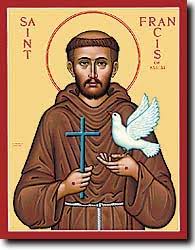
The Feast Day of St. Francis of Assisi is ~ October 4th
Born in Assisi, Italy in 1181 (or 1982), St. Francis had all the comforts and luxuries of life. Christened Giovanni by his mother, Giovanni, he was, however, renamed Francesco by his wealthy father, Pietro di Bernardone, who happened to be away on business at the time of his birth.
In keeping with the trend of the times, Francis, a highly popular romantic, sought knighthood-and passionately so! Thus in 1202, when Assisi went to war against Perugia, his involvement cost him a year in prison. Recovering from a serious illness that followed, his attempt in late 1205 to join the papal forces against Frederick II in Apulia came to naught when a vision at Spoleto bid him return to Assisi and there await a call to a new kind of knighthood whereby he would “serve the Master rather than the man”- the start of his conversion.
In solitude and prayer he now passionately sought to know God’s will for him. His newfound concern for the poor and the sick reached its peak when he one day dismounted his horse to give alms to a leper by the wayside, and wonder of wonders, held the deformed figure in a warm embrace that, in his own words, changed “bitterness to sweetness”! Shortly after, in response to the command from the cross at San Damiano’s Church, “Francis, go repair my house which, as you see, is falling into ruin,” he instantly set about repairing old , dilapidated San Damiano’s, even disposing off some of his father’s silk stock to acquire funds for the purpose. The dispute that ensued had his father hauling him up before the Bishop, demanding the recovery of the money. Francis obliged instantly – virtually stripping himself, he handed over all his clothes to his father together with the money and made himself a beggar overnight, for the sake of his great Master.
On 24th February 1208, in the centuries old chapel of St Mary of the Angels, also known as the Portiuncula (“little portion”), he perceived clearly at Mass the Lord’s plan for him in Mathew 10:5-14. Thence, though a layman, he began to preach passionately to all sundry, styling himself the “herald of the great king”. The very simplicity of his life and teaching drew around him men of prominence like Bernard da Quintavalla, a wealthy merchant, Giles the ecstatic and others.
On 16th April 1209, with the enrobing of Peter of Catteneo, a Canon of the Cathedral, was born the Order of Friars Minor, “little brothers”, with a rule based purely on the gospel, viz, “to follow the teachings of our Lord Jesus Christ and to walk in his footsteps.” and with Mary, Queen of the Angels as their guide and protector.
When Friars numbered 12 with the entry of the immensely wealthy Angelo di Ugone in 1210, Francis sought formal papal approval for his new order and obtained it from Pope Innocent III. Incidentally, Francis declined priestly ordination out of reverence for the priesthood whose dignity he considered himself unworthy of.
Francis considered nature the very mirror of God and so in his famous Canticle of Brother sun, he referred to the sun as brother, the moon as sister, the earth as mother and so on. He brought its significance to perfection when, on his deathbed he repeatedly exclaimed, “Praised be, O Lord, for our sister Death!” Greatly troubled by an eye ailment he had contracted in the East, and his body ridden with dropsy, Francis patiently prayed, O Lord, I thank you for the pains I suffer”. Th significance of the poverty that was basic to Francis’ Charism as not mere external poverty but a total self-emptying like that of Christ that he sought (as in Phil 2:7) now began to emerge more clearly. In his dying moments, he sought and obtained permission from his superior to be allowed to die naked on the bare earth in imitation of his dear Lord and Master, Jesus Christ. On 3rd October 1226 Francis breathed his last at the Portiuncula, the very place that had witnessed the revelation of his mission and the birth of his Orders.
Francis’ mortal remains were initially buried in the church of San Giorgio at Assisi on 4th October and later transferred to the Basilica erected to his memory by Brother Elias of Cortona, on 25th May 1230. Canonized on 16th July 1228 by Pope Gregory IX, Francis was called by Pope Benedict XV the “most perfect image of Christ” that ever lived! In 1916, he was declared patron of Catholic Action; in 1926, Pope Pius XI termed him alter Christus, i.e “another Christ”, and rightly so, for as the New Encyclopaedia Brittanica (vol 4) says; “Probably no one in history has ever set himself so seriously, as did Francis, to imitate the life of Christ and to carry out literally Christ’s work in Christ’s own way. This is the key to the character and spirit of St. Francis. To neglect this point is to show an unbalanced portrait of the saint as a lover of nature, a social worker, an itinerant preacher, and a lover of poverty.”
In 1939, this most cherished of Christian Saints, was proclaimed patron of Italy.
Reflection: “We adore you and we bless you, Lord Jesus Christ, here and in all the churches which are in the world, because by your holy cross you have redeemed the world”. (St. Francis d’Assisi)
Members of St. Francis of Assisi going about some of the activities that help in their growth as Christians…..




